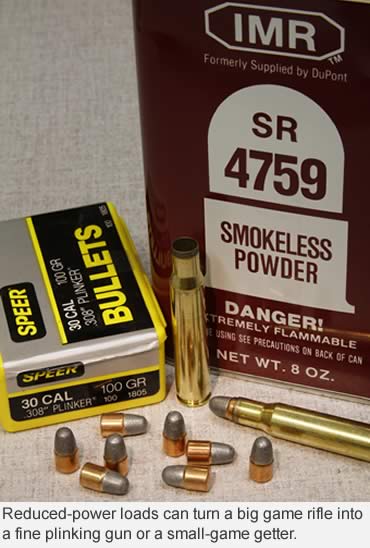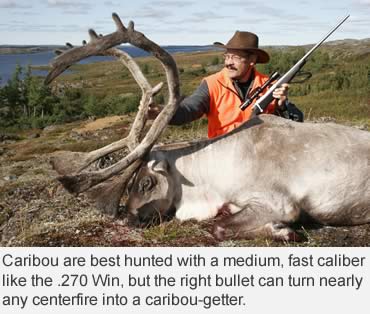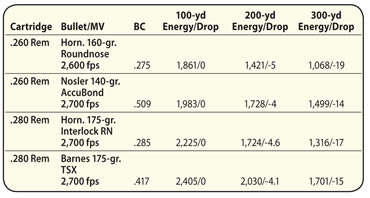Turn your big-game rifle into a jack of all trades with light and heavy loads.
Photo: How versatile can a cartridge be? The .260 Rem pushing a tough, deep-penetrating bullet can be deadly on moose and eland.
You invest $1,000 in a fancy new deer rifle, $1,000 in a scope and perhaps shoot your rig 10 times a year — three to sight-in, six to practice and one to take your deer. At that rate, you’re paying $20 per shot (not counting the price of the ammo) to use your rifle for a decade.
Slash that operating cost by making your deer rifle work overtime.
How about some coyote hunting? Elk hunting? A quick trip to Africa doesn’t cost any more than a really good elk hunt, and you can take kudu, gemsbok, impala, springbok and probably a half-dozen cull animals.
What about helping a farmer with an excess of burrowing rodents? Now we’re talking overtime hours.
Then there is long-range target shooting for fun and education. Hitting your first steel gong at 600 yards is almost as satisfying as taking your second elk at any range (not the first elk; nothing beats that).
With long-range targets, you work your fancy scope overtime, too, getting valuable practice. Use that dial turret or those extra crosshairs.
How about some squirrel or bunny hunting? Don’t laugh. A centerfire deer rifle works just fine on small game. You just have to know which ammo to use.
 Years ago, great granddad used a single rifle to take deer, turkey, elk, bears, squirrels and woodchucks, and he probably ran off a few chicken thieves with it, too. Nowadays, we often purchase more discretionary goods than we need. This is not to even faintly suggest your .223 Rem, .22-250 Rem, .243 Win, .25-06 Rem and .270 WSM are excessive. But, well . . .
Years ago, great granddad used a single rifle to take deer, turkey, elk, bears, squirrels and woodchucks, and he probably ran off a few chicken thieves with it, too. Nowadays, we often purchase more discretionary goods than we need. This is not to even faintly suggest your .223 Rem, .22-250 Rem, .243 Win, .25-06 Rem and .270 WSM are excessive. But, well . . .
In tough economic times like today’s, even those of us who understand the need for one rifle in every chambering (if not every action style) realize we can’t afford them all, and perhaps we should make one do the work of two or four. Here’s how.
Handload Light
This is almost essential to wring the most from any centerfire rifle. Factory ammo is excellent, but doesn’t extend the performance range as far as it could. Look through stocks of .30-06 ammo and see how many reduced-power 100-grain loads you can find. Stuff a stubby little 100-grain roundnose bullet from Hornady, Sierra or Speer atop 16 grains of SR 4759 powder (recipe from Speer Reloading Manual #14) for around 1,550 fps, and you have a superb, mild-recoiling practice round that’s cheap and reasonable for head-shooting small game.
You can do this with most centerfire cartridges. Your hot .22-250 Rem can be tamed to a more reasonable 2,000-fps rabbit plinker by downloading the powder charge. Ditto a .243 Win, .25-06 Rem, .270 Win or .300 Win Mag.
Don’t go about this process by merely sprinkling a little of any kind of powder in the case. This could result in a stuck bullet in the barrel, or worse, a blown-up rifle. Reducing the powder charge too much can result in cartridge detonation. Use only reliable loading data from manuals, and make sure you don’t double charge a case.
Both the Speer Reloading Manual and the Lyman Reloading Handbook include reduced-power loads.
 Lighter bullets can be loaded for maximum speed to make a deer caliber suitable for varmints. The Berger 110-grain FB Target bullet leaves a .308 Win barrel at about 3,300 fps. The bullet’s BC is .284, higher than most 50-grain .224 bullets. The result is flat trajectory. Sighted dead on at 200 yards, the Berger will be 1.3 inches high at 100 yards, 6.3 inches low at 300 yards and 19 inches low at 400. A 10-mph right-angle wind will cause just 9 inches of deflection at 300 yards.
Lighter bullets can be loaded for maximum speed to make a deer caliber suitable for varmints. The Berger 110-grain FB Target bullet leaves a .308 Win barrel at about 3,300 fps. The bullet’s BC is .284, higher than most 50-grain .224 bullets. The result is flat trajectory. Sighted dead on at 200 yards, the Berger will be 1.3 inches high at 100 yards, 6.3 inches low at 300 yards and 19 inches low at 400. A 10-mph right-angle wind will cause just 9 inches of deflection at 300 yards.
You can make the .30-30 shoot flatter by handloading light bullets, but be sure to take special precautions with sharp tips. Stacked in a tubular magazine, sharp-pointed bullets can detonate the primers ahead of them during recoil.
You can handload sharp bullets if you never stack them in the magazine. Put one in the chamber and one in the magazine. That’s it. If you don’t understand this and adhere strictly to it, no one else is responsible for ruining your rifle.
Those pointy-tipped 110-grain Bergers should hit 2,700 or 2,800 fps out of a .30-30. Because this bullet has a high BC compared to flat-nose models, it flies flatter. Sighted an inch high at 100 yards, it will land just 2.7 inches low at 200 and 14 inches low at 300, making it a reasonable varmint/coyote tool.
Handload Heavy
At the other end of the spectrum are extra-heavy, extra-long bullets. These will always reduce velocities in a given case, but can increase retained energy downrange if they are sleek and sharp. Longer, heavier slugs increase penetration, just what you want for big, tough game.
In the old days, when all bullets had lead cores surrounded by gilding metal jackets, the only way to increase penetration on big game was to reduce velocity (which reduced impact energy and mushrooming) or increase bullet length.
Today’s tougher, more durable controlled-expansion bullets retain enough weight to equal the penetration of much heavier cup-and-core bullets. Nevertheless, an extra-heavy bullet of any construction can still provide the kind of deep penetration insurance many like, especially for self-defense shots at charging bears.
 If these heavier bullets are sleek and sharply pointed, like the Bergers and Sierras, they’ll have high BC ratings and resist wind drift better than shorter bullets. But they may have to be seated so deep in the cartridge that they use up considerable powder space, further reducing velocity.
If these heavier bullets are sleek and sharply pointed, like the Bergers and Sierras, they’ll have high BC ratings and resist wind drift better than shorter bullets. But they may have to be seated so deep in the cartridge that they use up considerable powder space, further reducing velocity.
This isn’t usually a problem inside 200 yards, where most extra-heavy bullets are needed. They’ll also retain more energy farther downrange. This means a .260 Rem or .280 Rem could perform on a huge moose or brown bear about as effectively as a .300 magnum.
Another option is to use a heavy roundnose slug. These are shorter than the high-BC slugs and fit better in many rifles/cartridges. But those blunt, round noses shed velocity and energy quickly as they fight air drag. They are best for close work, less than 100 yards. The chart (left) compares some heavy bullets in calibers most don’t think of as heavy hitters for big, tough game.
Factory ammo suffices for most needs, but to increase the versatility of your rifle, try handloading bullets at the light and heavy ends of their categories. Make your rifle shoot overtime and get your money’s worth.
Read Recent GunHunter Articles:
• Which .22 Centerfire? It’s hard not to like cartridges with names like Swift, Hornet and Fireball. Here’s what they do best in the field.
• The Hunter’s Telescope: There is no magic in a spotting scope; it just looks that way.
This article was first printed in the October 2011 edition of Buckmasters GunHunter Magazine. Subscribe today to have GunHunter delivered to your home.